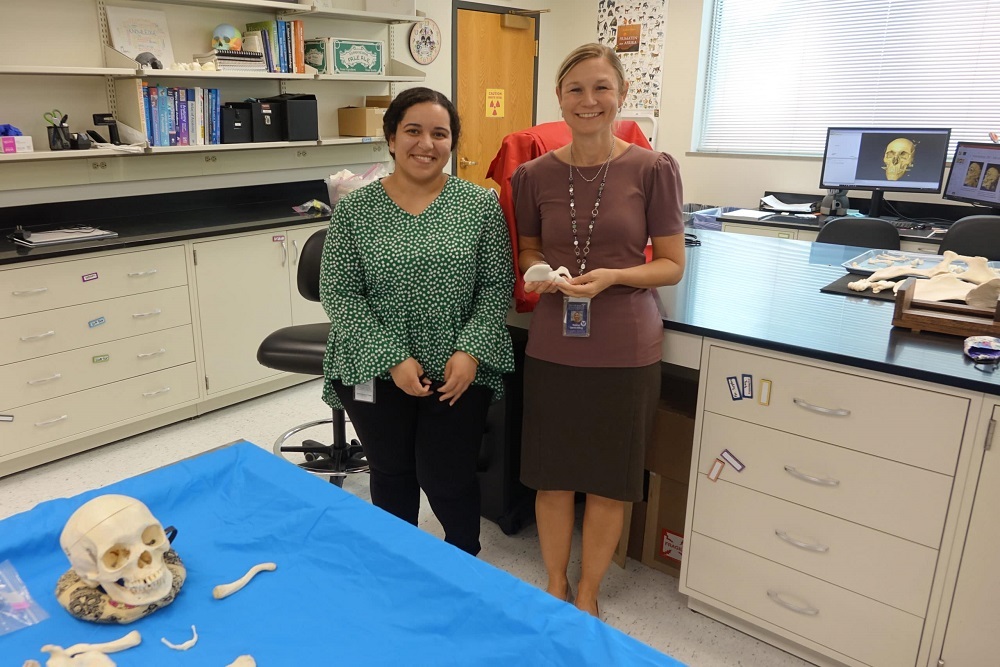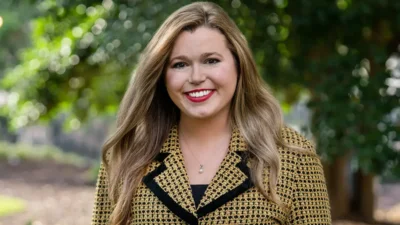Des Moines University issued the following announcement on August 31.
The bottom line of an article by a DMU faculty member and students recently published in the Journal of Forensic Sciences, “Sex estimation of the subadult ilium prior to acetabular fusion,” is that in in the forensic skeletal analyses of children and youth, pelvic remains should not be used to estimate biological sex. And while that isn’t the positive finding people like to see coming out of research, knowing which forensic methods are valid and which are not is critical.
Dr. Heather Garvin, holding a 3D model of a subadult pelvic bone, and Ph.D. student Merna Mohamed were among the authors of an article about their research, part of a larger project relating to standards of forensic analysis.
“The worst thing you can do in a forensic analysis is to be wrong – it could mean a decedent never gets identified,” says lead author Heather Garvin, Ph.D., D-ABFA, associate professor of anatomy at DMU and one of approximately 90 board-certified forensic anthropologists in the nation. Co-authors of the article include Katherine “Kasia” Marciniec, D.O.’22; Merna Mohamed, M.S., Ph.D.’25; and Elizabeth Ternent, D.O.’21.
Dr. Garvin says that pelvic remains can be used to estimate the sex of adults with 95 percent accuracy, but for subadults, the scientific literature “was all over the place.” That may be because access to subadult skeletal samples is highly limited, and many previous studies were based on skeletal collections from the early 1900s or before, the researchers state. They examined CT scans obtained from the University of New Mexico Health Sciences Center of 397 individuals aged zero to 14 years. Part of their analysis focused on the ilium, the large broad portion of the pelvis we think of as our hips, which is a sexually diagnostic feature in adults. But the substantial changes the pelvis undergoes from birth until adolescence make the ilium a less reliable sex indicator for younger individuals.
“We have a lot to learn about the growth and development of the skeleton,” she says.
This recent research was part of a larger project to define and create new standards for forensic analysis of subadults. It is supported by a grant from the National Institute of Justice that Dr. Garvin brought to DMU when she joined the faculty in 2017 as well as by funding from DMU’s Mentored Student Research Program and a DMU IOER R&G grant. She and the students have presented aspects of their work in recent years at the annual DMU Research Symposium.
Two of those presenting students, Kasia Marciniec and Merna Mohamed, were among her co-authors of the Forensic Sciences article. Both were new to anatomical research when they joined Dr. Garvin’s lab, but they relished the experience.
“As someone who enjoys watching ‘Dateline’ as a hobby, I have always been interested in forensic anthropology/pathology. Knowing Dr. Garvin is a forensic anthropologist, I emailed her and asked if there was any project I could get my hands on and was offered a research position for a study to determine whether the subadult pelvis can be used for sex estimation,” Kasia says. Now a fourth-year student in the University’s osteopathic medicine program, she worked on the project from January through December 2019 and presented posters at DMU’s Mentored Student Research Program finale that summer and the DMU Research Symposium that December.
She worked mainly in the anatomy lab, using special software to analyze images of ilia. “I learned how much time commitment and minutia goes into gathering true research in order to conclude a hypothesis and determine whether results are statistically and/or clinically significant,” she says. “I also learned how to write an abstract and research poster, something I hope to continue to do in the future in other fields.”
Merna joined Dr. Garvin’s lab in 2019-2020, her senior year at Drake University, for her capstone project for her health sciences major. She presented a poster about her work at the 2019 DMU Research Symposium and stayed on during the summer after she graduated, primarily segmenting skeletal elements from CT scans.
“I was really interested in getting research experience, and Dr. Garvin was my top pick among preceptors,” she says. “I really like the process research – defining what you’re trying to figure out and the steps to get there. There are hiccups along the way, so you adjust. Plus you get to share what you learned.”
Now one of the first students in DMU’s new Ph.D. program in biomedical sciences, Merna says the project motivated her to do study outside the lab. “I had not taken an anatomy course before joining Dr. Garvin’s lab,” she says.
She describes her preceptor’s style as a combination of hands-on instruction and hands-off independence. “Dr. Garvin would train me and guide me on a process, then give me space to think it through,” Merna says. “She’s all you would want in a mentor.”
Original source can be found here.



 Alerts Sign-up
Alerts Sign-up